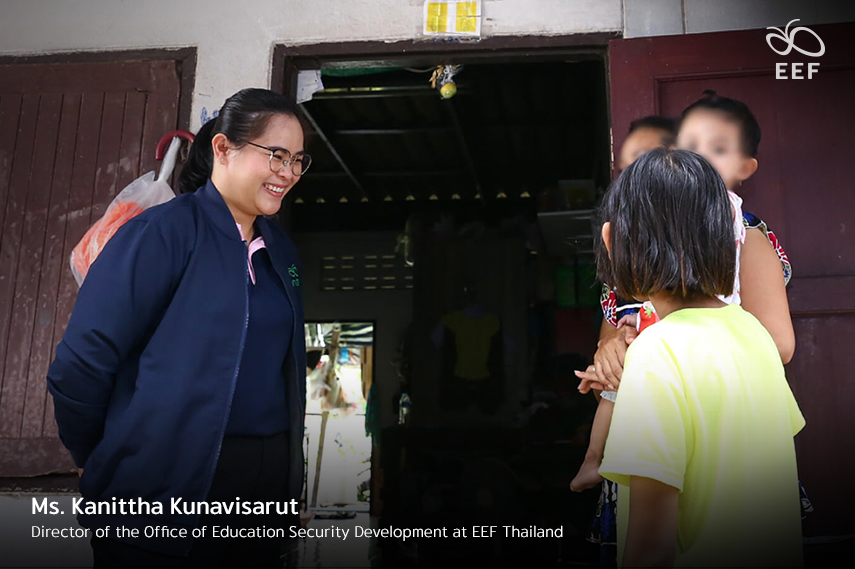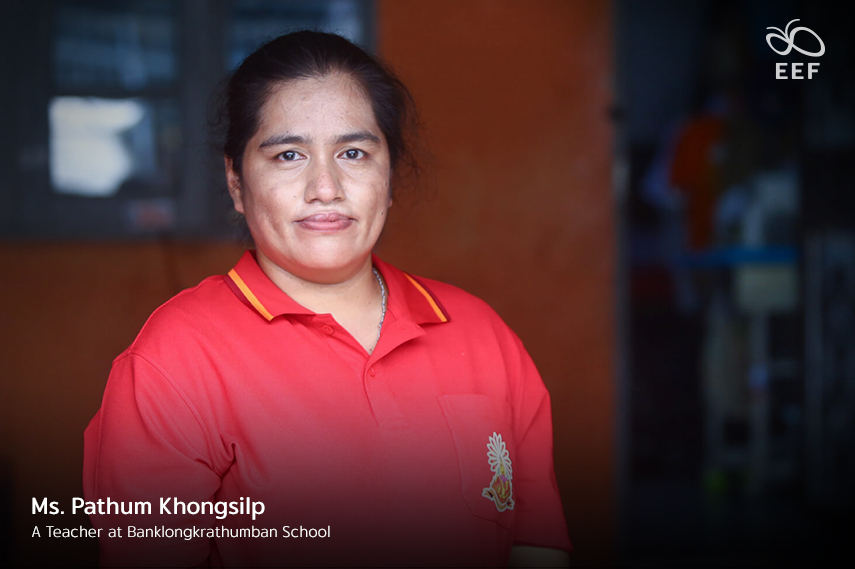
Equitable Education Fund (EEF) Thailand, through its Office of Education Security Development, conducted a field visit to exchange knowledge and support the Conditional Cash Transfer (CCT) program. This visit aimed to follow up on students who have re-entered the education system based on data from the Thailand Zero Dropout project. It was a collaborative effort with Banklongkrathumban School and WatOmNoi School in Krathum Ban District, Samut Sakhon Province. Involved school administrators, teachers, and representatives from the Office of Samut Sakhon Primary Educational Service Area.

Ms. Kanittha Kunavisarut, Director of the Office of Education Security Development at EEF Thailand, presented the progress of the CCT program. She highlighted that, following home visits by teachers nationwide in June, approximately 40,000 out-of-school youth from the Thailand Zero Dropout database had entered the education system for the first semester of 2024. Some of these are children and youth aged 3-18 who are entering schools for the first time. All new students will be assessed according to the CCT program criteria, with a new list of scholarship recipients to be announced in August.
“The importance of cooperation extends beyond providing scholarships; it involves creating a sustainable quality education system that ensures comprehensive support for all students to access education until completion. This includes opportunities to access other available scholarships. When children return to school, they will receive holistic care across economic, social, health, and family dimensions to minimize the risk of dropping out again. Therefore, collaboration between schools and various agencies is crucial in guiding these students toward higher education.”

Following the meeting to exchange and gather experiences from teachers involved in the CCT program, the teachers guided the EEF Thailand team on a home visit to students benefiting from the program and to children from the Thailand Zero Dropout database who have entered school this semester.
“The Equitable Education Fund (EEF) Thailand would like to extend our gratitude to all the teachers for their ongoing support. Each area has its unique context. In Samut Sakhon Province, an industrial area where most parents work in factories, there is a high and continuous rate of student mobility. Additionally, many children who are older than the typical age are entering school for the first time. Therefore, it is crucial to understand how local teachers conduct screening processes and manage subsidy payment data. This insight can be applied to schools within the same area. Importantly, once children are identified and enrolled, there must be a system for tracking, monitoring, assisting, and referring them to ensure they have access to opportunities for personal development until they achieve their educational goals, whether continuing to higher education or engaging in learning formats that meet their life needs, in line with the Thailand Zero Dropout program’s objectives.”

The Director of the Office of Education Security Development, Equitable Education Fund (EEF) Thailand, noted that the Thailand Zero Dropout mission encompasses various dimensions, with working through educational institutions being a key component. Screening students for the CCT program helps facilitate care and support measures, including grants to overcome educational barriers. Even those who do not meet the CCT program criteria but are in the school system database will receive care and assistance if they face risks in other areas.
Thus, the role of teachers is vital, as it enables comprehensive support for children throughout their time in the education system. Visits to Banklongkrathumban School and WatOmNoi School demonstrated that despite the schools’ significant challenges, including a large proportion of children in need of assistance, the dedication and efforts of teachers provide these children with valuable opportunities, whether they are at risk of dropping out or are re-entering the school system.
“A common situation in Samut Sakhon is children over ten years old starting Grade 1. This often occurs due to the necessity of their parents’ occupations, which require frequent relocation. In such cases, it is crucial to consider how to design an effective learning path. When inquiring about the family’s and child’s needs, one potential solution is to establish a long-term pathway to vocational studies. This approach could provide an opportunity to earn an income and may help reduce the frequency of relocations.”

Ms. Pathum Khongsilp, a teacher at Banklongkrathumban School, said that each semester, the school records individual student data in the Data Management Center (DMC). This involves visiting homes and talking with parents and community leaders. Once the data is collected, students’ names are submitted to the CCT program for screening. The school also has a policy of ‘Connecting Support,’ ensuring that students identified as having financial difficulties receive the necessary resources and comprehensive support. The information gathered from these home visits is crucial for providing appropriate support to ‘every child’ based on their specific needs, whether they are financially disadvantaged, facing health issues, or dealing with family problems. The school uses this data to design personalized pathways for each student, considering diverse contexts, including academic education, vocational training, informal education, Department of Learning Encouragement (DOLE), short-term vocational programs, and connections with the Department of Social Development and Human Security (MSDHS) or special education teachers (SPED).
“Our students come from various backgrounds, regions, and ethnicities. Most are children whose parents have moved here for work, with an increasing number being born in the area due to their parents’ prolonged employment. Their educational status is often ‘unstable’ due to constant mobility. Some students may study for a while, then return to live with relatives in their hometowns. Others might need to move with their parents when they find new jobs, or they may drop out and return intermittently. Tracking these students is challenging, as some may re-enroll only to disappear again after 3-4 months, while others may drop out for years and, when located, are often older than their peers and less ready to return to school. The school’s primary goal is to ‘design learning pathways that enable students to complete their education.’ At a minimum, students should achieve a Grade 6 education or complete compulsory education. After graduation, the school will work with local educational networks to ensure a 100% transition to higher levels of education. For those not ready to continue due to the need to earn a living, such as children living with grandparents who rely solely on old-age pensions, the school will continue to provide case-by-case support. This includes finding opportunities for further education or encouraging them to pursue vocational training based on their interests and skills.”

Ms. Nipa Sritongkam, a teacher at WatOmNoi School, explained that the school’s student support system is based on comprehensive home visit data for every child, supplemented with additional information from OBEC’s surveys to ensure care is both appropriate and contextually relevant. In Om Noi Subdistrict, nearly every child has parents who work in local factories, most of whom lack stable housing and have low incomes. Many families are single-parent households, with children often living with grandparents and in areas prone to drug problems. Consequently, data collection must be thorough, reliable, and include photographic evidence of the actual conditions.
“Our screening is managed by the classroom teachers, who provide detailed reports on the number of students in each class, how many have been screened, how many have received scholarships, and how many have not. We also monitor students who have moved out of the area or do not meet the scholarship criteria, with reasons provided, to ensure no child is overlooked. The school’s policy is that by screening all students, we are creating opportunities for them. Therefore, all teachers are committed to this process. Even if a child does not receive a scholarship from the CCT program, the data can still direct them toward other opportunities or scholarships. We use the ‘Findstudentship’ website compiled by Equitable Education Fund (EEF) Thailand to explore various scholarships for students.”

Ms. Nipa Sritongkam emphasized that the screening of students each semester and the detailed attendance reports by classroom teachers are key mechanisms that ensure WatOmNoi School maintains a zero dropout rate. Regular updates, from weekly to daily, help identify at-risk students who may be about to leave the system, enabling timely intervention. For students who are absent for more than three days, seven days, or up to two weeks, teachers visit their homes to understand the issues and develop suitable support strategies. For instance, if health issues are identified, the school will coordinate with public health agencies. If employment is a concern, the school will offer flexible learning options, allowing students to attend at least 2-3 days a week until the end of the semester and participate in final exams, ensuring they have academic records for further education.
“The importance of real-time student data tracking, as mentioned, is due to our context involving factory settings. Many students come and go; some stay for only one semester or one year, and parental circumstances can frequently change. We continuously communicate with parents to request their cooperation in data collection, as this provides a basis for connecting students to other scholarships and timely, appropriate support and assistance.”

